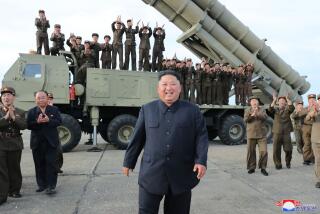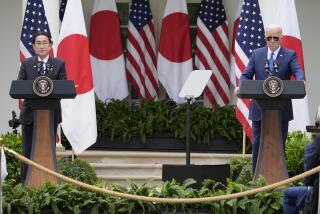Koizumi’s North Korea Risk
- Share via
Japan’s Prime Minister Junichiro Koizumi’s trip to North Korea later this month appears to be a positive development in reducing tensions on the Korean peninsula. But appearances can be deceiving.
Koizumi’s surprise announcement reflects positively on Japan’s attempts to play a leadership role in the region. He appears to be taking on the thorny problem of North Korea when the fate of South Korean President Kim Dae Jung’s “sunshine policy” of reaching out to Pyongyang remains uncertain.
Moreover, U.S. ambivalence about engaging North Korea remains palpable enough that an initiative of this sort by a trusted ally may yield the transparency needed for Washington to make the decision to pursue engagement in earnest. Or it may not.
Japan deserves kudos for taking this initiative, but is Koizumi being set up as the straight man for Bush hawks? Koizumi must not fall into the trap that Kim did in coming back from Pyongyang with handshakes and photo ops but no substantive agreements. Indeed, smiling faces (and nothing else) is just the proof that Bush hawks need to validate their belief that North Korean leader Kim Jong Il is not serious about engagement.
The most meaningful issue for Japan and the U.S. relates to North Korea’s No Dong missiles. Hundreds of these ballistic missiles, unlike the longer-range Taepodong missile, are deployed in North Korea. Any logical extrapolation of North Korea’s strategic doctrine suggests that these missiles, which can be fitted with chemical warheads, are targeted on Japan (to deter the U.S. and Japan from supporting South Korea in a military confrontation).
Can Japan persuade the North to concede on this issue? It’s doubtful. The North refused to discuss No Dong deployments in the missile negotiations with the U.S. at the end of the Clinton administration.
So therein lies the problem: Koizumi must come back from Pyongyang with something of substance, especially since the North so badly disrespected Tokyo in normalization talks at the end of 2000. Japanese negotiators were led to believe then that the basic outlines of a package were in the making. However, it’s unlikely that meaningful missile agreements are in the offing even now. Facing pressure for results, Koizumi might therefore fall into the trap of handing over some carrots (such as cash) for small, incremental and symbolic concessions by the North.
This sort of summit might play in Seoul but not in Washington or Tokyo. Bush hawks would have their “proof” that engagement with Pyongyang is fruitless.
Behind this diplomatic theater is a deeper and more disturbing message. Combined with Kim Jong Il’s meeting in August with Russian President Vladimir V. Putin and persistent entreaties by Beijing and Seoul, Koizumi’s trip could be seen as another voice in the regional chorus for Bush to support engagement with Pyongyang.
But these voices have the unintended effect of widening a gap in policy toward North Korea between Washington and its Asian allies. For the latter, Koizumi’s impending trip again validates the merits of engagement and Kim Dae Jung’s sunshine policy. They believe that engagement will eventually bring the North around. But for the Bush administration, Koizumi’s trip reinforces the efficacy of the harder line: Calling the regime evil and taking the hawk, not sunshine, approach has pressed the North into its conciliatory mode.
The further the openings to the outside by North Korea, the wider this perception gap--and the differences in policy--between the U.S. and its allies in Asia.
More to Read
Sign up for Essential California
The most important California stories and recommendations in your inbox every morning.
You may occasionally receive promotional content from the Los Angeles Times.










